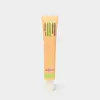What's inside
What's inside
 Key Ingredients
Key Ingredients

 Benefits
Benefits

 Concerns
Concerns

 Ingredients Side-by-side
Ingredients Side-by-side

Water
Skin ConditioningGlycerin
HumectantNiacinamide
SmoothingDistarch Phosphate
AbsorbentPropanediol
SolventOleic Acid
EmollientSclerotium Gum
Emulsion StabilisingSorbitan Olivate
EmulsifyingPunica Granatum Seed Oil
EmollientAscorbyl Palmitate
AntioxidantXylityl Sesquicaprylate
AntimicrobialCetearyl Olivate
Sodium Benzoate
MaskingDecyl Glucoside
CleansingLinoleic Acid
CleansingPotassium Sorbate
PreservativeBisabolol
MaskingLauryl Glucoside
CleansingTocopherol
AntioxidantHyaluronic Acid
HumectantAminomethyl Propanol
BufferingIron Oxides
Anhydroxylitol
HumectantAlgin
MaskingGlyceryl Undecylenate
EmollientTocopheryl Acetate
AntioxidantBentonite
AbsorbentGlyceryl Caprylate
EmollientCaffeine
Skin ConditioningMica
Cosmetic ColorantCI 77163
Cosmetic ColorantCaprylic/Capric Triglyceride
MaskingCalcium Citrate
BufferingCitric Acid
BufferingSodium Lauroyl Lactylate
EmulsifyingResveratrol
AntioxidantSodium Metabisulfite
AntioxidantWater, Glycerin, Niacinamide, Distarch Phosphate, Propanediol, Oleic Acid, Sclerotium Gum, Sorbitan Olivate, Punica Granatum Seed Oil, Ascorbyl Palmitate, Xylityl Sesquicaprylate, Cetearyl Olivate, Sodium Benzoate, Decyl Glucoside, Linoleic Acid, Potassium Sorbate, Bisabolol, Lauryl Glucoside, Tocopherol, Hyaluronic Acid, Aminomethyl Propanol, Iron Oxides, Anhydroxylitol, Algin, Glyceryl Undecylenate, Tocopheryl Acetate, Bentonite, Glyceryl Caprylate, Caffeine, Mica, CI 77163, Caprylic/Capric Triglyceride, Calcium Citrate, Citric Acid, Sodium Lauroyl Lactylate, Resveratrol, Sodium Metabisulfite
Water
Skin ConditioningCoco-Betaine
CleansingGlycereth-26
HumectantPEG/PPG-8/3 Laurate
EmulsifyingCocamidopropyl Betaine
CleansingSodium Cocoyl Alaninate
Sodium Cocoyl Isethionate
CleansingSodium Methyl Cocoyl Taurate
CleansingLaureth-2
CleansingPEG/PPG-120/10 Trimethylolpropane Trioleate
Pyrus Malus Fruit Water
MaskingDisodium Cocoyl Glutamate
CleansingPhenoxyethanol
PreservativeLauryl Glucoside
CleansingDecyl Glucoside
CleansingCitric Acid
BufferingEthylhexylglycerin
Skin ConditioningDisodium EDTA
Copper Tripeptide-1
Skin ConditioningWater, Coco-Betaine, Glycereth-26, PEG/PPG-8/3 Laurate, Cocamidopropyl Betaine, Sodium Cocoyl Alaninate, Sodium Cocoyl Isethionate, Sodium Methyl Cocoyl Taurate, Laureth-2, PEG/PPG-120/10 Trimethylolpropane Trioleate, Pyrus Malus Fruit Water, Disodium Cocoyl Glutamate, Phenoxyethanol, Lauryl Glucoside, Decyl Glucoside, Citric Acid, Ethylhexylglycerin, Disodium EDTA, Copper Tripeptide-1
Ingredients Explained
These ingredients are found in both products.
Ingredients higher up in an ingredient list are typically present in a larger amount.
Citric Acid is an alpha hydroxy acid (AHA) naturally found in citrus fruits like oranges, lemons, and limes.
Like other AHAs, citric acid can exfoliate skin by breaking down the bonds that hold dead skin cells together. This helps reveal smoother and brighter skin underneath.
However, this exfoliating effect only happens at high concentrations (20%) which can be hard to find in cosmetic products.
Due to this, citric acid is usually included in small amounts as a pH adjuster. This helps keep products slightly more acidic and compatible with skin's natural pH.
In skincare formulas, citric acid can:
While it can provide some skin benefits, research shows lactic acid and glycolic acid are generally more effective and less irritating exfoliants.
Most citric acid used in skincare today is made by fermenting sugars (usually from molasses). This synthetic version is identical to the natural citrus form but easier to stabilize and use in formulations.
Read more about some other popular AHA's here:
Learn more about Citric AcidDecyl Glucoside is a glucose-based surfactant and emulsion stabilizer. It is created by reacting glucose with the fatty acids from plants.
Surfactants help clean the skin by trapping oil, sebum, and dirt to be washed away. As an emulsion stabilizer, it stabilizes the ingredients in a product by preventing them from separating.
This ingredient is biodegradable and non-toxic. This ingredient is commonly found in baby shampoos.
Decyl Glucoside is sometimes used to stabilize the UV filter Tinosorb.
Learn more about Decyl GlucosideLauryl Glucoside sugar- and lipid-based cleansing agent. It is created from glucose and lauryl alcohol.
This ingredient is a surfactant, making it easier to rinse oil, dirt, and other pollutants away.
A British study found lauryl glucoside to cause skin sensitivity for some people. We recommend speaking with a professional if you have concerns.
Other names for this ingredient include "Lauryl Polyglucose", "Lauryl glycoside", and "D-Glucopyranoside".
Learn more about Lauryl GlucosideWater. It's the most common cosmetic ingredient of all. You'll usually see it at the top of ingredient lists, meaning that it makes up the largest part of the product.
So why is it so popular? Water most often acts as a solvent - this means that it helps dissolve other ingredients into the formulation.
You'll also recognize water as that liquid we all need to stay alive. If you see this, drink a glass of water. Stay hydrated!
Learn more about Water